“Pump” Carpenter and the grain binder
How do inventors decide what to work on?
by Jason Crawford · March 31, 2021 · 6 min read
Inventors sweat and tinker for years, sometimes decades, before their inventions work—if they ever do. But how do they choose what to work on? What or who inspires and directs them?
I was thinking about this after coming across a little gem buried in Herbert Casson’s biography of Cyrus McCormick, inventor of an automatic reaping machine.
Some context. In the 1800s, a lot of inventive effort went into the mechanization of agriculture. Agriculture requires many tasks—tilling the soil, planting seeds, spreading fertilizer, weeding—but nothing cried out for mechanization more than the reaping of wheat. Plowing was already assisted by draft animals. Threshing grain (to separate the seed from its outer shell) was done by hand, but during the winter, when labor was in low demand. Reaping had to be done immediately once the grain ripened, within a span of about a week, and it was done by hand.
Thus a machine to automatically reap wheat was a major goal of inventors in the early 1800s. The first practical reapers were invented in the 1830s and began to become adopted by farmers in the 1840s. McCormick was a central figure in this story: he had a few reaper patents to his name, and he founded what would become one of the largest manufacturers of reapers.

But the first reapers only automated the cutting of wheat. They still required manual labor for a few more steps. First, someone had to walk alongside the machine with a rake, and rake off bundles of wheat as they accumulated on the platform. Second, as in the pre-industrial days, other people had to come along behind the reaper to tie the bundles together. The bundles were then stood up in the fields to dry before being taken back to the barn for threshing.
In the 1840s, a seat was added so the guy with the rake could ride instead of walking. Around the 1860s, “self-rake” reapers were made that did the raking themselves, automatically dumping loose bundles of wheat on the ground, to be tied up by hand.
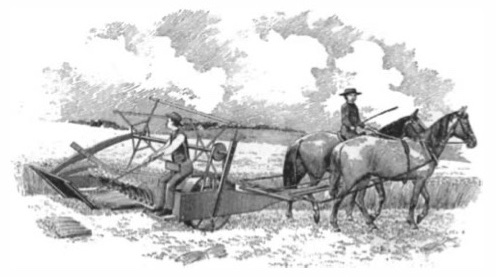
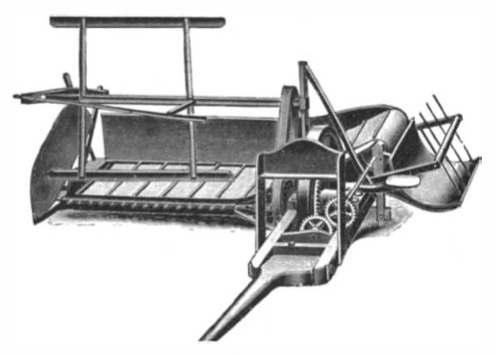
Next, it was the binders who got to ride along, binding by hand while standing up, rather than walking and stooping over. Finally, in the 1870s, “self-binding” reapers were invented, which automated the binding, and deposited tied-up bundles on the ground. The first successful binding machine was invented by Charles B. Withington of Madison, Wisconsin.
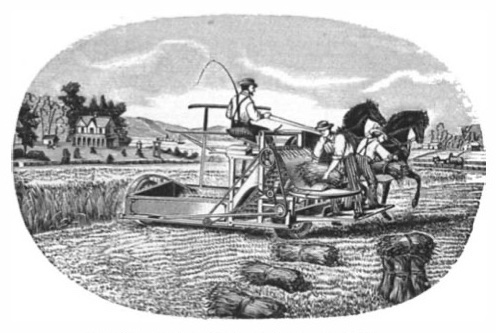
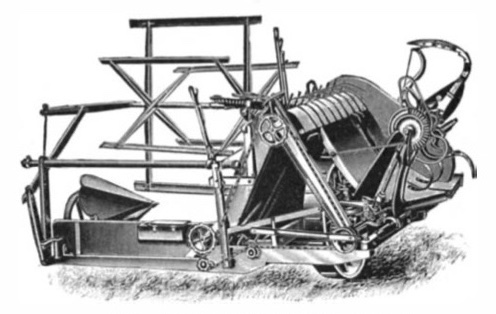
How did Withington decide to work on a grain binder?
Here’s the interesting bit from Casson’s biography. Apparently, Withington at first was not working on a binder. Instead, he was working on a “self-raker,” which in retrospect was an intermediate evolutionary step.
What made him switch his focus? Casson writes:
As it happened, the whole southern region of Wisconsin was being stirred up at that time by the speeches of an inventive Madison editor, who went by the name of “Pump” Carpenter. Carpenter’s hobby was that the binding of grain must be done by machinery. He was eloquent and popular, and his arguments were substantiated by a little model which he was accustomed to carry about with him.
Stephen Decatur “Pump” Carpenter was a newspaper man: over the years, he ran the Wisconsin Argus, Democrat, and Patriot. He was also an inventor himself. He has a couple of patents on a rotary pump, which seems to have been the origin of his nickname. And he was one of the first to obtain a patent on an automatic grain binder, in the 1860s. A book titled American Agricultural Implements says: “His machine created considerable of a sensation, was successfully exhibited and a number experimentally built, but they did not get it upon the market.” Presumably the “little model” he carried around was of his own invention.
Carpenter demonstrated his machine on a number of occasions, including at a Wisconsin State Fair in 1867, but it wasn’t reliable. On Aug 28, 1869, the Wisconsin State Register wrote of the machine:
It ran across the field, leaving a row of neat and strongly bound bundles in its wake; but unfortunately an accident prevented further operations…. The accident yesterday had so disabled the binder that it was difficult to work it…. The binder was started again, but it was found that it would be necessary to take some of the machinery to the shop for repairs before it would work successfully…. The principle is correct—it does the work—but the strengthening and perfecting of the various parts is a work of time.
I’m guessing that the stirring speeches that Casson refers to were simply Carpenter promoting his own invention, as he evidently did for many years. But he seems to have ended up inspiring other inventors to work on the problem as well. Casson continues:
Withington heard him speak and was converted. He dropped his self-rake reaper and went to work upon a self-binder. He completed his first machine in 1872, and was thrust from one discouragement to another until two years later he met McCormick.
(McCormick licensed Withington’s binder for the machines made by his company.)
Further, Casson claims that Withington may not have been the only one inspired by “Pump”:
It is a most interesting fact, and certainly not an accidental one, that the group of noted inventors who together produced the self-binder all appeared from the region south of Madison, which had been so aroused by the eloquence of “Pump” Carpenter. Besides C. B. Withington, there were Sylvanus D. Locke, also of Janesville, H. A. Holmes, of Beloit, John F. Appleby, of Mazomanie, W. W. Burson, Jacob Behel, George H. Spaulding, and Marquis L. Gorham, of Rockford.
Nor were these other names all failures: Appleby invented a binder that used twine, which quickly obsoleted Withington’s machine, which used wire (wire could be dangerous to humans, cattle, and machines). And then, when Appleby’s invention was used by a competitor, McCormick hired Gorham to design a twine binder for his own machines.
Did Carpenter really influence all of these inventors, or any of them? I haven’t been able to substantiate this claim. Casson’s biography has no citations, not even a bibliography. A more scholarly biography by William Hutchinson mentions many of these inventors, including Carpenter and Withington, but says nothing of their influence on each other. I have not found a biography of either Carpenter or Withington.
Nor have I uncovered any of Carpenter’s stirring speeches. There are plenty of newspaper reports of Carpenter’s demonstrations from 1866 on, but the only relevant speech I found reference to was one from 1870 where he talked about how much time and money he had put into the invention so far. He does pitch the opportunity for a farmer to save $25 to $30 a day ($500–$600 in today’s money). One newspaper editor was so taken that he “thanked God that S. D. Carpenter had been given to the world, and felt like writing his name by the side of Watts [sic], Morse, Fitch and Fulton.” Maybe the speech was stirring after all.
The only information I have found about the inspiration for any of the binder inventors is an article quoting Appleby telling the story of his twine binder. He was inspired by the work done at a small machine shop near the farm where he grew up, and seems to have gotten the idea to work on a binder from actually doing the manual labor himself, in the 1850s. He doesn’t mention “Pump”.
So, I’m not sure whether these lines of influence are real, a baseless rumor, a misremembered story, or a fanciful embroidery on Casson’s tale. If you can dig up anything about this, send it my way.
The reason I did a deep dive on this narrow and relatively minor topic is that it’s a clue to a broader theme.
Scientists, engineers, and tinkerers are naturally curious. They experiment for the joy of creation as much as for any practical benefit to humanity. And even when they are motivated to make an impact on the world, they don’t automatically choose important goals. Choosing what problem to solve, it turns out, is a different task and a different skill than implementing the solution. People who are good at one may not be good at the other. That’s why the world needs managers, executives, and CEOs.
But there’s more than one way to lead. Grantmakers at research foundations, such as Warren Weaver at the Rockefeller Institute, or Harry Weaver at the National Foundation for Infantile Paralysis, lead through their funding decisions. And there is even “softer”, more indirect leadership as well simply in promoting an idea and inspiring the efforts of others—whether through professional writing and speaking, works of futurism, or even science fiction.
Whatever form it takes, we should recognize and value direction-setting as a crucial role in driving progress.
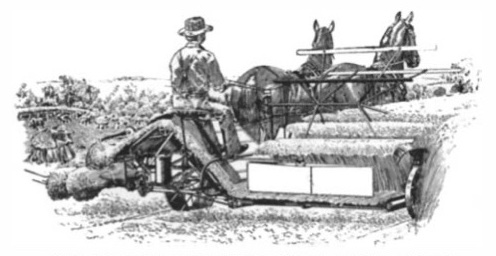
Thanks to Anton Howes for help researching this essay. All images above are from an 1896 issue of Scientific American.
Comment on Reddit
